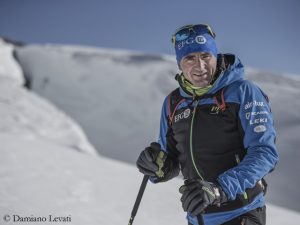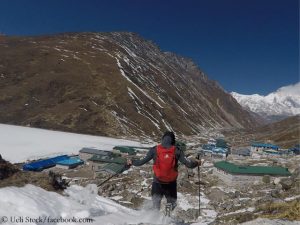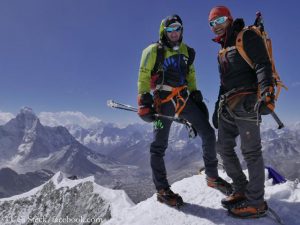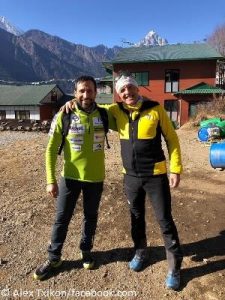Steck before Everest expedition: “Rather late than early”
He looks forward, not back. “I will never forget what happened on Everest in 2013,” the Swiss top climber Ueli Steck tells me. “But I believe I will have absolutely no problem with it. It’s over. I’m very motivated and I’ll go with a very good feeling.” In spring 2013, a Sherpa mob had attacked Steck, the Italian Simone Moro and the Briton Jonathan Griffith and had threatened them with death. This spring, Ueli will return to the highest mountain on earth. His goal: the traverse of Mount Everest and Lhotse. The 40-year-old will climb with Tenji Sherpa, with whom he had already scaled Everest without bottled oxygen in 2012. The 24-year-old belongs to “a new generation of Sherpas, who really enjoy climbing and are not only interested in doing business,” says Ueli. “I’m really looking forward to being en route with him.”
As reported, Steck had completed an intensive training camp with the German David Goettler and the Italian Hervé Barmasse in the Khumbu area in February. Subsequently, Ueli returned to Switzerland for a few weeks. He will set off to Kathmandu on 8 April.
Ueli, during the training Camp in Nepal in February you ran and climbed a total of about 250 kilometers with 15,000 meters in elevation. How much has been added since then?
I am not quite sure. I have no longer made such a large scale, but focused on intensive training. However, last week I made another 10,000 meters in elevation. So probably a total of 25,000 meters have been added.
What does this intensive training look like?
Mainly, I do interval and threshold training. These are relatively short units of physical stress, but with a high pulse frequency. This is to push the maximum pulse.
How is your current physical condition?
If you ask me today, it’s actually perfect. I can not change many things anymore, it is only fine-tuning. I can not manage a big increase in performance before I leave. But at the moment I am in top form, my performance parameters are actually sensational. Very likely, I will now do it this way every year.
How will you continue your acclimatization in Nepal?
I will go straight to Everest Base Camp. As I see it, I might ascend to Camp 2 [at 6,400 meters] on the second day after arrival and spend some time there. For me, it is also important that I have slept two nights on the South Col at almost 8,000 meters before it really starts. But for sure, I will also climb up to the West Shoulder during acclimatization to see how the conditions are.
Do you still prefer doing the traverse via the West Shoulder?
It would be the most elegant if we are able to traverse the summit ascending via the Hornbein Couloir, then descending to the South Col and up to the summit of Lhotse. That would be my dream. But I am also realistic and experienced enough to know that it can only work if very, very much matches: There must be perfect conditions and the weather must be good and stable. I think it’s important to have ideas, but in the end you have to decide on the mountain what is possible and impossible.
The Everest-Lhotse traverse has never been achieved without the use of supplemental oxygen. How high do you assess the chance of success?
There must something be going quite wrong, so that the traverse via the normal route turns out to be impossible. But we’ve seen it last year on Shishapangma: If the weather doesn’t fit, you have just no chance. You never know beforehand how high the chance really is. But I believe I am able to succeed.
Many expect a record spring season on Everest, meaning that the mountain will be really crowded. This doesn’t sound like ideal conditions for an ambitious project such as a traverse.
It doesn’t have any influence how many people are on the mountain. It doesn’t matter if the people get stuck in a traffic jam on the fixed rope. You do not need to use it and can climb on the side.
Could it be your tactics to schedule the summit attempt as early as possible in the season?
Early in the season, there is often the problem that it’s still very cold. If you go without bottled oxygen, however, it should be relatively warm. Therefore, it’s most likely not an option to set off early. I’ll go rather late. Let the first weather window pass by, then most climbers have already been on the summit, and it will become calmer on the mountain. I think, this is the more likely option.











